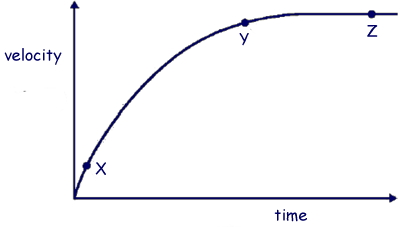GCSE Questions: Forces
Q1. The diagram below shows the horizontal forces acting on a moving bicycle and cyclist.

(a)
(i) Which of the following causes force A?
| X |
friction  |
| Y |
gravity |
| Z |
weight |
[1 mark]
(ii) What causes force B?
Drag 
[1 mark]
(iii) The graph shows how the velocity of the cyclist changes during the first part of a journey along a straight and level road. During this part of the journey the force applied by the cyclist to the bicycle pedals is constant.

Describe how and explain, in terms of the forces A and B, why the velocity of the cyclist changes:
 between the points X and Y marked on the graph and
between the points X and Y marked on the graph and
 between the points Y and Z, marked on the graph.
between the points Y and Z, marked on the graph.
Between points X and Y the cyclist accelerates.  This is because the drag on the cyclist depends on the speed at which he is travelling. The faster he goes the greater the drag force (B) will be.
This is because the drag on the cyclist depends on the speed at which he is travelling. The faster he goes the greater the drag force (B) will be.  As the force from his pedaling (A) is constant, this results in a smaller net forward force (A-B), resulting in decreasing acceleration.
As the force from his pedaling (A) is constant, this results in a smaller net forward force (A-B), resulting in decreasing acceleration.  He therefore increses his speed between X and Y, but the rate of increse decreases as he gets faster.
He therefore increses his speed between X and Y, but the rate of increse decreases as he gets faster.  By the time he reases Z drag is equal to the force from his pedaling.
By the time he reases Z drag is equal to the force from his pedaling.  (A = B so A - B = 0) This results in no net forward force
(A = B so A - B = 0) This results in no net forward force and he cycles at a constant speed, his terminal velocity.
and he cycles at a constant speed, his terminal velocity.
[6 marks]
(b)
(i) The cyclist used his brakes to slow down and stop the bicycle.
A constant braking force of 140 N stopped the bicycle in a distance of 24 m.
Calculate the work done by the braking force to stop the bicycle.
Work done = force x distance moved 
= 140 N x 24 m
= 3360  J
J 
[3 marks]
(ii) Complete the following sentences.
When the brakes are used, the bicycle slows down. The kinetic energy of the bicycle decreases.  At the same time, the temperature (or thermal energy)
At the same time, the temperature (or thermal energy)  of the brakes increases.
of the brakes increases.
[2 marks]
[13 Marks TOTAL]


